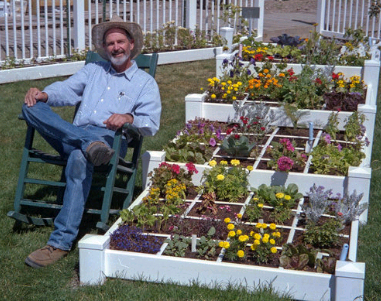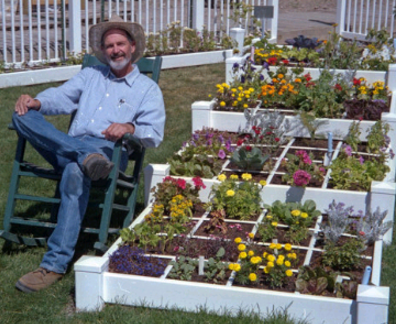What is square foot gardening? A simple, unique and versatile system that adapts to all levels of experience, physical ability, and geographical location. Grow all you want and need in only 20% of the space of a conventional row garden. Save time, water, work and money! I am following the square foot gardening method, and I'll be using it as a reference through out the blog. Square foot gardening invented by the genius Mel Bartholomew! Learn more about it in his website , Or order his very very valuable book. It may come in downloadable PDF files too, if you search. 
Here are the 10 things that make SFG different from traditional row gardening:
- Layout. Arrange your garden in squares, not rows. Lay it out in 4′x4′ planting areas. Companion plants can help each other grow bigger and tastier!
- Boxes. Build boxes to hold a new soil mix above ground. Your existing soil doesn't matter! forget about it, and just worry about the new soil called Mel's Mix.
- Aisles. Space boxes 3′ apart to form walking aisles. It makes it easier to walk and sit around the boxes, especially when your plants get really big and spill out of the boxes a little.
- Soil. Fill boxes with Mel’s special soil mix: 1/3 blended compost (please please make your own! The compost sold in Kuwait is a little shady) , 1/3 peat moss, and 1/3 coarse vermiculite (All available in True Value).
- Grid. Make a permanent square foot grid for the top of each box. A MUST!
- Care. NEVER WALK ON YOUR GROWING SOIL. This is how the soil stays so fluffy and airy for the roots stay happy. Tend your garden from the aisles.
- Select. Plant a different flower, vegetable, or herb crop in each square foot, using 1, 4, 9, or 16 plants per square foot. You might, for example, plant a single tomato in a square, but you’d plant 16 carrots in another. Using this system, you can cram a lot of garden into a small space and still get excellent yields.
- Plant. Conserve seeds. Plant only a pinch (2 or 3 seeds) per hole. Place transplants in a slight saucer-shaped depression. This means you wont waste seeds! The traditional way is to plant lots of seeds then cut off the majority and leave the strongest.
- Water. Water by hand from a bucket of sun-warmed water.
- Harvest. When you finish harvesting a square foot, add only compost and replant it with a new and different crop.
 I decided how big of an area I want to use, I am placing my SFG on the roof of my house, which I made sure received at least 8 hours of full sun. I am going big and starting with lots of boxes. So after thorough planning I decided I want two 4x4 square foot boxes (which is the standard) two smaller boxes for root vegetables like carrots and potatoes, and one long box for herbs. You can download the guide I created for the carpenters here . Its not the most accurate illustration of what the boxes look like in the end, but the numbers are right.
I decided how big of an area I want to use, I am placing my SFG on the roof of my house, which I made sure received at least 8 hours of full sun. I am going big and starting with lots of boxes. So after thorough planning I decided I want two 4x4 square foot boxes (which is the standard) two smaller boxes for root vegetables like carrots and potatoes, and one long box for herbs. You can download the guide I created for the carpenters here . Its not the most accurate illustration of what the boxes look like in the end, but the numbers are right. You can change the measurements how ever you like, most importantly, you have to make sure each square is 1ft squared in size= 30 cm. Also Most vegetables require 6 inches of soil, I've decided to use around 20cm. If the boxes are placed over a garden/soil, they don't need bottoms. In my case, I have to apply bottoms since they're going to be in the roof. The bottoms are waterproof 2cm thick plywood. The plywood has to have around 0.6 cm holes drilled in each square, plus in the corners. My boxes have weird squares in the plywood because the carpenter mistook 0.6cm for huge 6cm holes, I had them fix them without problems. Potato/Carrot beds:
You can change the measurements how ever you like, most importantly, you have to make sure each square is 1ft squared in size= 30 cm. Also Most vegetables require 6 inches of soil, I've decided to use around 20cm. If the boxes are placed over a garden/soil, they don't need bottoms. In my case, I have to apply bottoms since they're going to be in the roof. The bottoms are waterproof 2cm thick plywood. The plywood has to have around 0.6 cm holes drilled in each square, plus in the corners. My boxes have weird squares in the plywood because the carpenter mistook 0.6cm for huge 6cm holes, I had them fix them without problems. Potato/Carrot beds:  One of the 4x4' beds with the herb bed:
One of the 4x4' beds with the herb bed:  You can of course build your own boxes, and a very detailed guide is in the book. Im sure its much more fun.I don't have the skill or time, so I had the boxes done for 50KD total, 30 for the wood and 20 for the building. The work was done by Ibrahim in Classic Design Carpentry :
You can of course build your own boxes, and a very detailed guide is in the book. Im sure its much more fun.I don't have the skill or time, so I had the boxes done for 50KD total, 30 for the wood and 20 for the building. The work was done by Ibrahim in Classic Design Carpentry :  Don't forget, you can collect sawdust for free and use it as a carbon source in your compost! Maybe I'll paint the outsides of the boxes with the kids before the season starts, what do you think?
Don't forget, you can collect sawdust for free and use it as a carbon source in your compost! Maybe I'll paint the outsides of the boxes with the kids before the season starts, what do you think?


25001 comments
http://tiny.cc/links1111
CP / PTHC / LOLITA FORUM
2500+ GB PHOTO / VIDEO COLLECTIONS
===== == drt9Z4 == =====
VICKY, TROPICAL CUTIES, TLZ, SANDRA,
PLAYPEN, FALKO, LOLI, VLADMODELS, LAURA,
APRIL, DDF, CASEY, JB, MAGIC KINGDOM.
http://tiny.cc/links1111
sites https://aviator-game-play.com/en/
ULTIMATE РТНС COLLECTION
NO PAY, PREMIUM or PAYLINK
DOWNLOAD ALL СР FOR FREE
Description:→ tiny.cc/zd48vx
Webcams РТНС since 1999 FULL
STICKAM, Skype, video_mail_ru
Omegle, Vichatter, Interia_pl
BlogTV, Online_ru, murclub_ru
Complete series LS, BD, YWM
Sibirian Mouse, St. Peterburg
Moscow, Liluplanet, Kids Box
Fattman, Falkovideo, Bibigon
Paradise Birds, GoldbergVideo
Fantasia Models, Cat Goddess
Valya and Irisa, Tropical Cuties
Deadpixel, PZ-magazine, BabyJ
Home Made Model (HMM)
Gay рthс collection: Luto
Blue Orchid, PJK, KDV, RBV
Nudism: Naturism in Russia
Helios Natura, Holy Nature
Naturist Freedom, Eurovid
ALL studio collection: from
Acrobatic Nymрhеts to Your
Lоlitаs (more 100 studios)
Collection european, asian,
latin and ebony girls (all
the Internet video) > 4Tb
Rurikon Lоli library 171.4Gb
manga, game, anime, 3D
This and much more here:
or → tiny.cc/sficzz
or —> citly.me/sVJSf
or —> 4ty.me/08yxs4
or —> tt.vg/fiJTt
or —> 7z.si/r9z9
or —> me2.kr/KBMgQ
or —> j1d.ca/_I
or —> put2.me/pwdcjb
or —> 74i.de/dekSToh
-———————-
-———————
000A000134
Подробнее здесь https://tripscanwin28.top
The CO2 that is extracted from the water is run through a purification process that uses activated carbon in the form of charred coconut husks, and is then ready to be stored.
[url=https://tripscan.biz]трипскан сайт[/url]
In a scaled up system, it would be fed into geological CO2 storage. Before the water is released, its acidity is restored to normal levels, making it ready to absorb more carbon dioxide from the air.
“This discharged water that now has very low carbon concentrations needs to refill it, so it’s just trying to suck CO2 from anywhere, and it sucks it from the atmosphere,” says Halloran. “A simple analogy is that we’re squeezing out a sponge and putting it back.”
While more tests are needed to understand the full potential of the technology, Halloran admits that it doesn’t “blow direct air capture out the water in terms of the energy costs,” and there are other challenges such as having to remove impurities from the water before releasing it, as well as the potential impact on ecosystems. But, he adds, all carbon capture technologies incur high costs in building plants and infrastructure, and using seawater has one clear advantage: It has a much higher concentration of carbon than air does, “so you should be able to really reduce the capital costs involved in building the plants.”
https://tripscan.biz
tripscan
Mitigating impacts
One major concern with any system that captures carbon from seawater is the impact of the discharged water on marine ecosystems. Guy Hooper, a PhD researcher at the University of Exeter, who’s working on this issue at the SeaCURE site, says that low-carbon seawater is released in such small quantities that it is unlikely to have any effect on the marine environment, because it dilutes extremely quickly.
However, that doesn’t mean that SeaCURE is automatically safe. “To understand how a scaled-up version of SeaCURE might affect the marine environment, we have been conducting experiments to measure how marine organisms respond to low-carbon seawater,” he adds. “Initial results suggest that some marine organisms, such as plankton and mussels, may be affected when exposed to low-carbon seawater.”
To mitigate potential impacts, the seawater can be “pre-diluted” before releasing it into the marine environment, but Hooper warns that a SeaCURE system should not be deployed near any sensitive marine habitats.
There is rising interest in carbon capture from seawater — also known as Direct Ocean Capture or DOC — and several startups are operating in the field. Among them is Captura, a spin off from the California Institute of Technology that is working on a pilot project in Hawaii, and Amsterdam-based Brineworks, which says that its method is more cost-effective than air carbon capture.
According to Stuart Haszeldine, a professor of Carbon Capture and Storage at the University of Edinburgh, who’s not involved with SeaCURE, although the initiative appears to be more energy efficient than current air capture pilot tests, a full-scale system will require a supply of renewable energy and permanent storage of CO2 by compressing it to become a liquid and then injecting it into porous rocks deep underground.
He says the next challenge is for SeaCURE to scale up and “to operate for longer to prove it can capture millions of tons of CO2 each year.”
But he believes there is huge potential in recapturing carbon from ocean water. “Total carbon in seawater is about 50 times that in the atmosphere, and carbon can be resident in seawater for tens of thousands of years, causing acidification which damages the plankton and coral reef ecosystems. Removing carbon from the ocean is a giant task, but essential if the consequences of climate change are to be controlled,” he says.